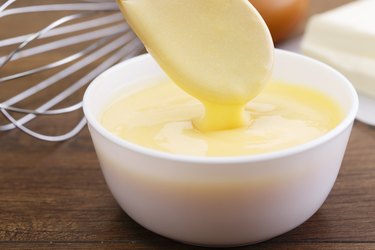
Tart, creamy hollandaise, the queen of the mother sauces, elevates eggs Benedict from a lowly breakfast dish to an elegant brunch star. Lemon brightens the rich sauce that's also good with steamed vegetables, fish and seafood. Add shallots and tarragon to hollandaise to create béarnaise, an herbaceous sauce for steak.
Béarnaise vs. Hollandaise
Video of the Day
The difference between hollandaise and béarnaise is quite simple. Hollandaise, one of legendary French chef Auguste Escoffier's five "mother sauces," is transformed into béarnaise sauce when tarragon and shallots are added.
Video of the Day
Making hollandaise can be a bit fussy because the sauce might break, or separate, if the temperature isn't just right or if the technique is slightly off. Have all of your ingredients and equipment ready before you begin. Egg yolks, water and vinegar are slowly heated in a double boiler until the yolks thicken. Melted butter is then slowly whisked into the egg mixture. The sauce is seasoned with lemon juice, salt and pepper.
For béarnaise, cook tarragon and shallots in wine and vinegar until the mixture reduces by half. Add it to hollandaise.
The Other Mother Sauces
- Bechamel: A
basic white sauce made with milk thickened with a flour and butter roux and
seasoned with salt and pepper. It is used as a base for cream soups, macaroni and
cheese, vegetable dishes and baked pasta.
- Veloute: A
butter and flour roux-based sauce made with chicken stock and seasoned with
salt and pepper. It is served with poultry, veal and seafood and is also used as a base
for other stocks like sauce aurora with tomato puree or Hungarian sauce with
paprika and onions. Veloute is also the base for cream soups.
- Espagnole: A
brown sauce made with a roux, beef stock, tomato puree and mirepoix made from carrots,
onion, garlic and celery. Rarely used on its own, it is the base for demi-glace,
mushroom sauce and sauce Bourguignonne made with red wine, shallots and herbs.
- Tomate: A
standard tomato sauce flavored with herbs like oregano and basil, served with
pasta, meat, rice, vegetables and any other recipe calling for tomato sauce.
Escoffier made his with roux, tomatoes, pork belly and seasonings.
Sauce Tips
- When making
a sauce that includes oil and vinegar, use three parts oil to one part vinegar.
- A mirepoix is usually three vegetables like onions, carrots and celery, cooked slowly until
tender. The Cajun "holy trinity" used in dishes like jambalaya and gumbo is
made from onion, bell pepper and celery.
- A roux, a
combination of equal parts flour and fat, is the thickening agent for sauces,
soups and stews. After the flour and fat have cooked together for anywhere from 3 to 20 minutes depending on how deep the color should be for your recipe,
a liquid is slowly whisked in and cooked until the sauce thickens.
- Strain
sauces containing mirepoix before serving or use a stick blender until the
sauce is smooth.
- Sauces like béarnaise,
sauce Dijon and sauce Maltaise that are based on one of the mother sauces are
called sister sauces.
- The
difference between hollandaise and mayonnaise, despite the similarity in names,
is that mayonnaise is an emulsion of oil and vinegar, egg yolk and mustard that
is not cooked.
- Béarnaise
sauce can be frozen, but hollandaise is better eaten immediately after it's
prepared.
- If you don't have a double boiler, use a metal bowl that fits on top of a saucepan. Add water to the saucepan and place the bowl on top, taking care that the bottom of the bowl doesn't touch the top of the water.
- Auguste Escoffier School of Culinary Arts: How to Make a Hollandaise
- JWU Recipes: Bearnaise Sauce
- Auguste Escoffier School of Culinary Arts: How to Make a Basic Mayonnaise
- Auguste Escoffier School of Culinary Arts: How to Make Bechamel Sauce
- Food Network: Veloute Sauce
- Auguste Escoffier School of Culinary Arts: Espagnole 101
- Auguste Escoffier School of Culinary Arts: Our Guide to Escoffier’s 5 Mother Sauces